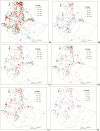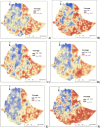Mapping BCG vaccination coverage in Ethiopia between 2000 and 2019
- PMID: 35739462
- PMCID: PMC9219134
- DOI: 10.1186/s12879-022-07547-4
Mapping BCG vaccination coverage in Ethiopia between 2000 and 2019
Abstract
Introduction: The Bacille-Calmette-Guerin (BCG) vaccination remains the primary strategy to prevent severe disseminated TB in young children, particularly in high TB-burden countries such as Ethiopia. Accurate knowledge of vaccination coverage in small geographical areas is critically important to developing targeted immunization campaigns. Thus, this study aimed to investigate the spatiotemporal distributions and ecological level determinants of BCG vaccination coverage in Ethiopia.
Method: Bacille-Calmette-Guerin immunization coverage and geographical information data were obtained from five different Demographic and Health Surveys, conducted in Ethiopia between 2000 and 2019. Data for independent variables were obtained from publicly available sources. Bayesian geostatistical models were used to predict the spatial distribution of BCG vaccination coverage in Ethiopia.
Result: The overall national BCG vaccination coverage between 2000 and 2019 was 65.5%. The BCG vaccine coverage was 53.5% in 2000, 56.9% in 2005, 64.4% in 2011, 79.6% in 2016, and 79.0% in 2019. BCG vaccination coverage increased by 47.6% in Ethiopia from 2000 to 2019, but substantial geographical inequalities in BCG coverage remained at sub-national and local levels. High vaccination coverage was observed in northern, western, and central parts of Ethiopia. Climatic and demographic factors such as temperature, altitude, and population density were positively associated with BCG vaccination coverage. Whereas, healthcare access factors such as distance to health facilities and travel time to the nearest cities were negatively associated with BCG vaccine coverage in Ethiopia.
Conclusion: Despite substantial progress in national BCG vaccination coverage, marked spatial variation in BCG coverage persists throughout the country at sub-national and local levels. Healthcare access and climatic and demographic factors determined the spatial distribution of BCG vaccination coverage. Maintaining a high level of vaccination coverage across geographical areas is important to prevent TB in Ethiopia.
Keywords: BCG; Coverage; Ethiopia; Immunization; Spatiotemporal.
© 2022. The Author(s).
Conflict of interest statement
The authors have no conflicts of interest to declare.
Figures



Similar articles
-
Spatial co-distribution of tuberculosis prevalence and low BCG vaccination coverage in Ethiopia.Sci Rep. 2024 Dec 30;14(1):31561. doi: 10.1038/s41598-024-68549-7. Sci Rep. 2024. PMID: 39738221 Free PMC article.
-
Spatial distribution of rotavirus immunization coverage in Ethiopia: a geospatial analysis using the Bayesian approach.BMC Infect Dis. 2022 Nov 9;22(1):830. doi: 10.1186/s12879-022-07825-1. BMC Infect Dis. 2022. PMID: 36352357 Free PMC article.
-
Spatiotemporal distributions of immunization coverage in Ethiopia from 2000 to 2019.Vaccine. 2022 Mar 1;40(10):1413-1420. doi: 10.1016/j.vaccine.2022.01.053. Epub 2022 Feb 4. Vaccine. 2022. PMID: 35125222
-
Immunization coverage and its determinant factors among children aged 12-23 months in Ethiopia: a systematic review, and Meta- analysis of cross-sectional studies.BMC Pediatr. 2020 Jun 8;20(1):283. doi: 10.1186/s12887-020-02163-0. BMC Pediatr. 2020. PMID: 32513135 Free PMC article.
-
BCG vaccination in India and tuberculosis in children: newer facets.Indian J Pediatr. 1994 Sep-Oct;61(5):451-62. doi: 10.1007/BF02751703. Indian J Pediatr. 1994. PMID: 7744445 Review.
Cited by
-
Low Measles Vaccination Coverage and Spatial Analysis of High Measles Vaccination Dropout in Ethiopia's Underprivileged Areas.Vaccines (Basel). 2024 Mar 19;12(3):328. doi: 10.3390/vaccines12030328. Vaccines (Basel). 2024. PMID: 38543962 Free PMC article.
-
Pulmonary tuberculosis case notification and burden of drug resistance among children under 15 years of age in Ethiopia: sub-analysis from third-round drug resistance tuberculosis survey.BMC Pediatr. 2023 Aug 24;23(1):418. doi: 10.1186/s12887-023-04240-6. BMC Pediatr. 2023. PMID: 37620787 Free PMC article.
-
Investigating the Spatial Accessibility and Coverage of the Pediatric COVID-19 Vaccine: An Ecologic Study of Regional Health Data.Vaccines (Basel). 2024 May 15;12(5):545. doi: 10.3390/vaccines12050545. Vaccines (Basel). 2024. PMID: 38793796 Free PMC article.
-
Spatial co-distribution of tuberculosis prevalence and low BCG vaccination coverage in Ethiopia.Sci Rep. 2024 Dec 30;14(1):31561. doi: 10.1038/s41598-024-68549-7. Sci Rep. 2024. PMID: 39738221 Free PMC article.
-
Strengthening primary health care in Ethiopia: A scoping review of successes, challenges, and pathways towards universal health coverage using the WHO monitoring framework.PLOS Glob Public Health. 2025 Apr 17;5(4):e0004470. doi: 10.1371/journal.pgph.0004470. eCollection 2025. PLOS Glob Public Health. 2025. PMID: 40244967 Free PMC article.
References
-
- Tafreshi SJVR. BCG vaccine and pulmonary tuberculosis. Vaccine Res. 2017;4(1):1–5.
-
- hebdomadaire WHOJWERRé. Weekly Epidemiological Record, 2004, vol. 79, 28 [full issue]. 2004;79 (28):253–64.
MeSH terms
Substances
LinkOut - more resources
Full Text Sources

